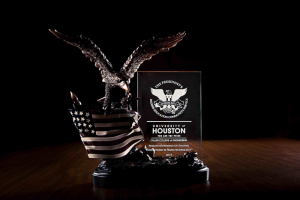Not only is University of Houston Cullen College of Engineering home to world-class research, it’s also a recognized leader in science and engineering outreach. The latest proof: the college’s Research Experience for Teachers (RET) program is one of three University of Houston Initiatives that together earned UH a spot on the 2013 President’s Higher Education Community Service Honor Roll with Distinction.
The honor roll program is run by the U.S. government’s Corporation for National and Community Service. It recognizes higher education institutions that “reflect the values of exemplary community service and achieve meaningful outcomes in their communities through service.” Out of more than 800 institutions that applied for this award, UH was one of just 113 named to the Honor Roll with Distinction. The formal nomination for the award was submitted by Larry Hill, a research professor with UH’s Graduate College of Social Work. In addition to the RET program, the UH efforts included in the nomination materials were the Houston Public Broadcast System and the College of Optometry’s Mobile Eye Institute.
The Cullen College’s “Innovations in Nanotechnology” RET program is led by Fritz Claydon and Stuart Long, both professors of electrical and computer engineering, and Debora Rodrigues, assistant professor of civil and environmental engineering. Funded by the National Science Foundation, the program brings about 12 middle and high school teachers to the college every summer to conduct nanotech-related research with a faculty expert.
With the assistance of a faculty mentor, teachers are then asked to design lessons for their students based on their time as a researcher.
Through the program, dozens of lessons and activities have been posted on teachengineering.org, a highly regarded website dedicated to providing teachers from kindergarten through 12th grade with engaging and informative lesson plans. “Because of the efforts we’ve made and the success we’ve had, the NSF is saying that the gold standard for [lesson plan] deliverables is the UH model,” said Claydon.
In addition, some of the RET participants have earned national recognition. High school physics teacher Mila Bersabal, a two-time RET participant and current RET program master teacher, was the 2009 State of Texas winner for the Presidential Awards for Excellence in Mathematics and Science Teaching. Through the RET program, she devised a lesson plan that had students use light waves to measure the spacing of nanoscale patterns (measured in the billionth of a meter) on CDs and DVDs.
Another notable RET participant is Madeline Landon, a 2009 RET high school student intern. Landon used her time in the program to study the use of seashells to remove harmful lead from drinking water. The project showed that the seashells’ chemical makeup caused chemical reactions that removed up to 90 percent of lead from water. This project earned first prize in Environmental Science in the ExxonMobil Texas Science and Engineering Fair and a "second award" in the Intel International Science and Engineering Fair.
“This college is committed to improving science and engineering education throughout the country, and the RET program is a big part of that,” said Claydon. “I’m glad to see that the program has been recognized with this honor. It shows that we’re really making an impact. The students, teachers and faculty mentors who support the program deserve a lot of credit for this success.”
